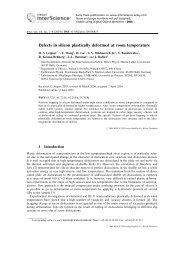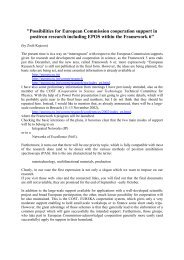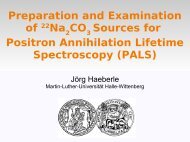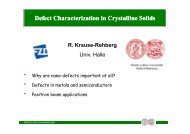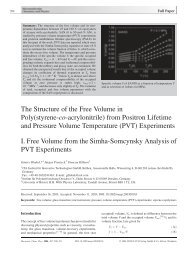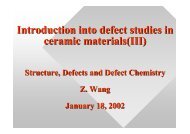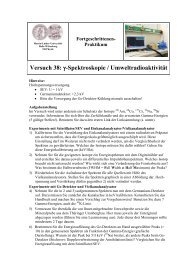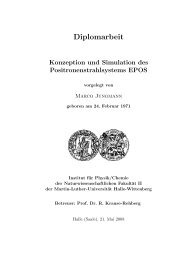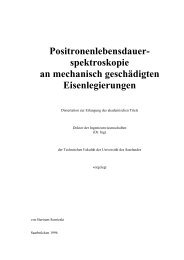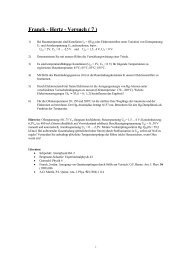Detection of vacancy-like defects during Cu diffusion in GaAs by ...
Detection of vacancy-like defects during Cu diffusion in GaAs by ...
Detection of vacancy-like defects during Cu diffusion in GaAs by ...
You also want an ePaper? Increase the reach of your titles
YUMPU automatically turns print PDFs into web optimized ePapers that Google loves.
International Workshop on Positron Studies <strong>of</strong> Defects (PSD 08) IOP Publish<strong>in</strong>g<br />
Journal <strong>of</strong> Physics: Conference Series 265 (2011) 012005 doi:10.1088/1742-6596/265/1/012005<br />
<strong>Detection</strong> <strong>of</strong> <strong>vacancy</strong>-<strong>like</strong> <strong>defects</strong> <strong>dur<strong>in</strong>g</strong> <strong>Cu</strong> <strong>diffusion</strong> <strong>in</strong> <strong>GaAs</strong><br />
<strong>by</strong> positron annihilation<br />
M Elsayed 1 , V Bondarenko, K Petters and R Krause-Rehberg<br />
Department <strong>of</strong> Physics, Mart<strong>in</strong> Luther University, 06099 Halle, Germany<br />
E-mail: mohamed.elsayed@physik.uni-halle.de<br />
Abstract. The positron annihilation spectroscopy is a method for direct characterization <strong>of</strong><br />
<strong>vacancy</strong>-type <strong>defects</strong> <strong>by</strong> measur<strong>in</strong>g the positron lifetime. It provides <strong>in</strong>formation about open<br />
volume and concentration <strong>of</strong> <strong>defects</strong>. Such measurements were carried out to study the defect<br />
properties <strong>of</strong> semi-<strong>in</strong>sulat<strong>in</strong>g <strong>GaAs</strong> after copper <strong>diffusion</strong>. A 30 nm layer <strong>of</strong> <strong>Cu</strong> was deposited<br />
<strong>by</strong> evaporation to undoped <strong>GaAs</strong> samples. The <strong>diffusion</strong> <strong>of</strong> <strong>Cu</strong> was performed <strong>dur<strong>in</strong>g</strong> an<br />
anneal<strong>in</strong>g step at 1100 °C under different arsenic vapor pressures. The samples were quenched<br />
<strong>in</strong>to room temperature water. The <strong>in</strong>itial semi-<strong>in</strong>sulat<strong>in</strong>g (SI) undoped <strong>GaAs</strong> sample shows no<br />
positron traps <strong>in</strong> that state. After gentle anneal<strong>in</strong>g, a <strong>vacancy</strong>-type defect complex <strong>in</strong> addition to<br />
shallow positron traps was observed to be an efficient positron trap. After <strong>Cu</strong> <strong>in</strong>-<strong>diffusion</strong><br />
<strong>dur<strong>in</strong>g</strong> the anneal<strong>in</strong>g process, the shallow positron trap is believed to be the <strong>Cu</strong>Ga double<br />
acceptor. The exact nature <strong>of</strong> the <strong>vacancy</strong>-<strong>like</strong> <strong>defects</strong> could not be determ<strong>in</strong>ed unambiguously.<br />
The concentration <strong>of</strong> these <strong>defects</strong> exhibits <strong>in</strong>verse relationship to the arsenic vapor pressure.<br />
Thus, the arsenic <strong>vacancy</strong> is believed to be part <strong>of</strong> this complex. The temperature-dependent<br />
Hall-effect measurements have revealed the presence <strong>of</strong> an acceptor level at EV + 0.5 eV that is<br />
usually attributed to <strong>Cu</strong>Ga.<br />
1. Introduction<br />
Despite extensive studies on <strong>GaAs</strong> <strong>dur<strong>in</strong>g</strong> the recent decades, we do not yet have a full understand<strong>in</strong>g<br />
<strong>of</strong> native po<strong>in</strong>t <strong>defects</strong> <strong>in</strong> this material. The thermodynamic properties <strong>of</strong> these <strong>defects</strong> <strong>in</strong> <strong>GaAs</strong> are <strong>of</strong><br />
great technological <strong>in</strong>terest. The thermodynamic analysis helps predict<strong>in</strong>g the concentrations <strong>of</strong> the<br />
po<strong>in</strong>t <strong>defects</strong> <strong>in</strong>corporated <strong>in</strong>to crystal under equilibrium conditions [1, 2]. The subject <strong>of</strong> the present<br />
work is the <strong>in</strong>vestigation <strong>of</strong> po<strong>in</strong>t <strong>defects</strong> quenched from different equilibrium states <strong>by</strong> means <strong>of</strong><br />
positron annihilation lifetime spectroscopy (PALS). The positron has proved to be a valuable<br />
nondestructive probe for <strong>vacancy</strong>-type <strong>defects</strong>. Dur<strong>in</strong>g the past decades, PAL has been <strong>in</strong>tensively<br />
applied to characterize <strong>defects</strong> <strong>in</strong> various semiconductors [3]. But <strong>in</strong> many cases it is difficult to<br />
conclude from the annihilation parameters alone which defect is responsible for the positron trapp<strong>in</strong>g.<br />
Basic thermodynamic considerations displayed <strong>in</strong> this paper helped us a lot <strong>in</strong> characteriz<strong>in</strong>g the orig<strong>in</strong><br />
<strong>of</strong> the observed <strong>vacancy</strong>-complex. The native po<strong>in</strong>t defect concentration can be expressed as a<br />
function <strong>of</strong> temperature and arsenic vapor pressure accord<strong>in</strong>g to the law <strong>of</strong> mass action [1].<br />
Copper is found as an un<strong>in</strong>tentional impurity <strong>in</strong> most semiconductors. This is ow<strong>in</strong>g to the fact that<br />
<strong>Cu</strong> is a rapidly diffus<strong>in</strong>g contam<strong>in</strong>ant already at low temperatures. <strong>Cu</strong> exhibits an unusually large<br />
1 Correspond<strong>in</strong>g author: Tel.: + 49-345-552-8502; Fax: + 49-345-552-7390.<br />
Published under licence <strong>by</strong> IOP Publish<strong>in</strong>g Ltd<br />
1
International Workshop on Positron Studies <strong>of</strong> Defects (PSD 08) IOP Publish<strong>in</strong>g<br />
Journal <strong>of</strong> Physics: Conference Series 265 (2011) 012005 doi:10.1088/1742-6596/265/1/012005<br />
<strong>diffusion</strong> coefficient <strong>in</strong> many semiconductor crystals. In <strong>GaAs</strong>, it was found to be as high as D =<br />
1.110 -5 cm 2 s -1 at 500 o C and D = 1.810 -9 cm 2 s -1 at 100 o C [4]. <strong>Cu</strong> diffuses very fast <strong>by</strong> <strong>in</strong>terstitial<br />
<strong>diffusion</strong> (kick-out process) [5]. Figure 1 presents the experimentally obta<strong>in</strong>ed solubility <strong>of</strong> <strong>Cu</strong> as a<br />
function <strong>of</strong> temperature as reported <strong>in</strong> Ref. 4. Moreover, the solubility was calculated to be 510 9 cm -<br />
3 at 100 o C [4]. Depend<strong>in</strong>g on the cool<strong>in</strong>g speed after a <strong>diffusion</strong> process, only a small fraction <strong>of</strong> the<br />
total <strong>Cu</strong> concentration is electrically active as acceptors. The portion <strong>of</strong> <strong>Cu</strong> that rema<strong>in</strong>s electrically<br />
<strong>in</strong>active forms <strong>Cu</strong>-Ga precipitates [6].<br />
Solubility ( cm -3 )<br />
10 19<br />
10 18<br />
10 17<br />
10 16<br />
400 600 800 1000<br />
Temperature ( o C )<br />
Figure 1. Solubility <strong>of</strong> <strong>Cu</strong> <strong>in</strong> undoped <strong>GaAs</strong> as a<br />
function <strong>of</strong> temperature (Ref. 4).<br />
2. Experimental<br />
The <strong>in</strong>vestigated samples were cut from the semi-<strong>in</strong>sulat<strong>in</strong>g undoped LEC grown <strong>GaAs</strong> wafer (55<br />
0.5 mm 3 ). The resistivity <strong>of</strong> <strong>in</strong>itial material was about 10 6 – 10 7 Ωcm. The samples were covered <strong>by</strong> 30<br />
nm <strong>Cu</strong> <strong>by</strong> evaporat<strong>in</strong>g it under UHV conditions. This amount <strong>of</strong> <strong>Cu</strong> corresponds to a volume<br />
concentration <strong>of</strong> 610 18 cm -3 which is approximately the upper solubility limit <strong>of</strong> <strong>Cu</strong> <strong>in</strong> <strong>GaAs</strong> at 1100<br />
o C [4]. The deposited layer thickness was controlled <strong>by</strong> a thickness measurement device (frequency<br />
shift <strong>of</strong> a crystal oscillator) which was calibrated before <strong>by</strong> Atomic Force Microscopy. High purity<br />
copper-free quartz ampoules HSQ300 (Heraeus Quarzglas GMBH&Co) were used for the <strong>Cu</strong><br />
<strong>diffusion</strong> anneal<strong>in</strong>g. Pure As (99.999%) was used as an arsenic source. The samples and the arsenic<br />
source were sealed <strong>in</strong> quartz ampoules under high vacuum. Anneal<strong>in</strong>g was performed for three hours<br />
<strong>in</strong> a two-zone temperature furnace at 1100 o C (sample temperature). The temperature <strong>of</strong> the arsenic<br />
source was varied <strong>in</strong> the region <strong>of</strong> 550 – 740 °C, which corresponds to an As-pressure <strong>of</strong> 0.2 – 9.68<br />
bar [7]. After anneal<strong>in</strong>g, the ampoules were quenched <strong>in</strong>to water at room temperature. Accord<strong>in</strong>g to<br />
the solubility, <strong>Cu</strong> is <strong>in</strong> oversaturated state and <strong>Cu</strong> atoms have the tendency to leave the lattice and start<br />
the out-<strong>diffusion</strong>, e.g. <strong>by</strong> form<strong>in</strong>g precipitates. Hall-effect measurements were applied to measure the<br />
samples <strong>in</strong> the as-quenched state. Thereafter, the samples were isochronally annealed <strong>in</strong> the<br />
temperature range up to 850 K. The samples were cooled down relatively slowly after each anneal<strong>in</strong>g<br />
step. Between the anneal<strong>in</strong>g steps, PALS measurements <strong>in</strong> the temperature range <strong>of</strong> 20 – 500 K were<br />
carried out us<strong>in</strong>g a conventional fast-fast co<strong>in</strong>cidence system with a time resolution <strong>of</strong> 225 ps. The<br />
2
International Workshop on Positron Studies <strong>of</strong> Defects (PSD 08) IOP Publish<strong>in</strong>g<br />
Journal <strong>of</strong> Physics: Conference Series 265 (2011) 012005 doi:10.1088/1742-6596/265/1/012005<br />
22 Na positron source was sandwiched between two identical 1.5 µm thick Al foils and placed between<br />
two identical samples. The spectra were analyzed with the two-component trapp<strong>in</strong>g model (one defect<br />
type) after source and background correction. The annealed SI <strong>GaAs</strong> samples were <strong>in</strong>vestigated <strong>by</strong><br />
temperature-dependent Hall-effect measurements (T = 293…373 K). The samples annealed at 0.2 and<br />
9.68 bar <strong>of</strong> As vapor pressure were chosen for chemical analysis <strong>by</strong> titration measurements.<br />
3. Result and Discussion<br />
The semi-<strong>in</strong>sulat<strong>in</strong>g undoped <strong>GaAs</strong> sample without any <strong>Cu</strong> deposition (reference sample) did not<br />
show any positron trapp<strong>in</strong>g. After <strong>Cu</strong> <strong>in</strong>-<strong>diffusion</strong>, the average lifetime <strong>in</strong>creases only slightly <strong>in</strong> the<br />
high-temperature region, which <strong>in</strong>dicates detection <strong>of</strong> a small number <strong>of</strong> <strong>vacancy</strong>-type <strong>defects</strong>. Figure<br />
2 represents the average positron lifetime versus measurement temperature after different anneal<strong>in</strong>g<br />
steps performed after <strong>Cu</strong> <strong>in</strong>-<strong>diffusion</strong>. A dist<strong>in</strong>ct decrease <strong>of</strong> the average lifetime at low temperatures<br />
is clearly shown for all curves. This is a typical dependence for shallow positron traps (negatively<br />
charged, non-open volume <strong>defects</strong>, such as ionized acceptors), which tend to trap positrons <strong>in</strong> the<br />
extended region <strong>of</strong> the Coloumbic potential, reflect<strong>in</strong>g there<strong>by</strong> the properties <strong>of</strong> the bulk as the<br />
annihilation characteristics <strong>of</strong> the positrons [3, 8]. Shallow traps are effective only at low temperatures<br />
due to the small b<strong>in</strong>d<strong>in</strong>g energy <strong>of</strong> positron, while at higher temperatures positrons are detrapped<br />
because <strong>of</strong> the high detrapp<strong>in</strong>g rate. Here, after <strong>Cu</strong> <strong>in</strong>-<strong>diffusion</strong>, the shallow traps must be ionized <strong>Cu</strong><br />
acceptor. Their concentration is up to 310 17 cm -3 accord<strong>in</strong>g to the Hall-effect measurements. Dur<strong>in</strong>g<br />
anneal<strong>in</strong>g up to 750 K, the average positron lifetime <strong>in</strong>creases strongly up to the value <strong>of</strong> 260 ps,<br />
<strong>in</strong>dicat<strong>in</strong>g the presence <strong>of</strong> <strong>vacancy</strong>-type <strong>defects</strong>. With a further <strong>in</strong>crease <strong>of</strong> the anneal<strong>in</strong>g temperature,<br />
a rapid decrease <strong>of</strong> the average positron lifetime was observed. With anneal<strong>in</strong>g at temperatures higher<br />
than 800 K the <strong>vacancy</strong> clusters grow and the distance between them becomes larger than the positron<br />
<strong>diffusion</strong> length. Thus, they become <strong>in</strong>visible for positrons [9].<br />
average positron lifetime (ps)<br />
265<br />
260<br />
255<br />
250<br />
245<br />
240<br />
235<br />
230<br />
as-quenched<br />
550 K<br />
600 K<br />
650 K<br />
700 K<br />
750 K<br />
800 K<br />
850 K<br />
0 100 200 300 400 500<br />
measurement temperature (K)<br />
3<br />
Figure 2. Average positron lifetime as a<br />
function <strong>of</strong> sample temperature <strong>in</strong> undoped<br />
SI <strong>GaAs</strong>. Prior to the experiment, about<br />
610 18 <strong>Cu</strong> atoms were <strong>in</strong>troduced <strong>by</strong><br />
evaporat<strong>in</strong>g a layer <strong>of</strong> 30 nm <strong>Cu</strong> onto the<br />
sample surface and <strong>by</strong> subsequent<br />
anneal<strong>in</strong>g at 1100 o C under 5.57 bar <strong>of</strong> As<br />
pressure (3h, then quenched <strong>in</strong>to water).<br />
The temperature-dependent lifetime<br />
experiment was carried out after each<br />
anneal<strong>in</strong>g step as illustrated <strong>in</strong> the figure.
International Workshop on Positron Studies <strong>of</strong> Defects (PSD 08) IOP Publish<strong>in</strong>g<br />
Journal <strong>of</strong> Physics: Conference Series 265 (2011) 012005 doi:10.1088/1742-6596/265/1/012005<br />
Figure 3 shows the anneal<strong>in</strong>g behavior <strong>of</strong> the average and defect-related lifetimes and its <strong>in</strong>tensity.<br />
It can be shown that the open volume <strong>of</strong> the detected <strong>vacancy</strong>-type defect <strong>in</strong>creases <strong>dur<strong>in</strong>g</strong> anneal<strong>in</strong>g.<br />
The defect-related lifetime <strong>in</strong>creases with <strong>in</strong>creas<strong>in</strong>g the anneal<strong>in</strong>g temperature but lies <strong>in</strong> the<br />
mono<strong>vacancy</strong> region until the anneal<strong>in</strong>g temperature 750 K. The defect-related lifetime reaches the<br />
value <strong>of</strong> 332 ps at 800K but with a low <strong>in</strong>tensity, which corresponds to divacancies (upper panel <strong>of</strong><br />
figure 4).<br />
Average positron lifetime (ps)<br />
Defect rel. lifetime (ps)<br />
Intensity<br />
260<br />
250<br />
240<br />
230<br />
350<br />
300<br />
250<br />
1.00<br />
0.75<br />
0.50<br />
0.25<br />
0.00<br />
measurement temperature: 466 K<br />
300 400 500 600 700 800 900<br />
anneal<strong>in</strong>g temperature (K)<br />
Figure 3. Positron lifetime results <strong>of</strong> the<br />
anneal<strong>in</strong>g experiment <strong>of</strong> undoped semi<strong>in</strong>sulat<strong>in</strong>g<br />
<strong>GaAs</strong> after <strong>in</strong>-<strong>diffusion</strong> <strong>of</strong><br />
610 18 cm -3 <strong>Cu</strong> atoms at 1100 o C under<br />
5.57 bar <strong>of</strong> As pressure. The average<br />
lifetime is shown <strong>in</strong> the upper panel. The<br />
defect-related lifetime and its <strong>in</strong>tensity<br />
versus the anneal<strong>in</strong>g temperature are<br />
plotted <strong>in</strong> the lower two panels. The<br />
spectra were measured at a sample<br />
temperature <strong>of</strong> 466 K to dim<strong>in</strong>ish the<br />
<strong>in</strong>fluence <strong>of</strong> the shallow traps.<br />
The lower panel <strong>of</strong> figure 4 represents the defect concentration versus the anneal<strong>in</strong>g temperature<br />
where the defect concentration <strong>in</strong>creases from 6.9710 16 cm -3 at 550 K up to 1.4910 17 cm -3 at 750 K<br />
and decreases aga<strong>in</strong> at 800 K. The defect concentration is determ<strong>in</strong>ed accord<strong>in</strong>g to equation (1):<br />
1 av -<br />
b<br />
KdC .<br />
(1)<br />
b d -av<br />
<br />
Kd is the trapp<strong>in</strong>g rate, μ is the trapp<strong>in</strong>g coefficient and taken as 10 15 s -1 at 300 K [10,11], τb is the bulk<br />
lifetime 230 ps [12,13], τav is the average positron lifetime and τd is the defect-related lifetime. The<br />
upper panel <strong>in</strong> figure 4 represents the number <strong>of</strong> vacancies versus the anneal<strong>in</strong>g temperature where the<br />
number <strong>of</strong> vacancies is one <strong>vacancy</strong> <strong>in</strong> the temperature range up to 750 K and <strong>in</strong>crease to be 2<br />
vacancies at 800 K. This was concluded accord<strong>in</strong>g to the calculation <strong>in</strong> Ref. 14 which is based on the<br />
superimposed-atom model <strong>by</strong> Puska and Niem<strong>in</strong>en [15].<br />
To show the effect <strong>of</strong> <strong>Cu</strong>, we would <strong>like</strong> to compare the results above to the sample which was not<br />
treated with <strong>Cu</strong> and annealed under very similar conditions. As shown <strong>in</strong> figure 5, the as-quenched<br />
sample shows a higher value <strong>of</strong> the average lifetime. This can be attributed to the trapp<strong>in</strong>g <strong>of</strong> positrons<br />
<strong>in</strong> vacancies. The pronounced decrease <strong>of</strong> the average positron lifetime at temperatures below 200 K,<br />
4
International Workshop on Positron Studies <strong>of</strong> Defects (PSD 08) IOP Publish<strong>in</strong>g<br />
Journal <strong>of</strong> Physics: Conference Series 265 (2011) 012005 doi:10.1088/1742-6596/265/1/012005<br />
may be expla<strong>in</strong>ed <strong>by</strong> positron trapp<strong>in</strong>g at negative ions (shallow traps), As C . Where semi-<strong>in</strong>sulat<strong>in</strong>g<br />
high resistive crystals are produced <strong>by</strong> <strong>in</strong>tentional dop<strong>in</strong>g <strong>of</strong> <strong>GaAs</strong> with carbon atoms, which are<br />
<strong>in</strong>corporated exclusively on the As sublattice form<strong>in</strong>g shallow acceptor-<strong>like</strong> <strong>defects</strong>, CAs [1]. But this<br />
cannot be identified from the results <strong>of</strong> positron lifetime alone. With <strong>in</strong>creas<strong>in</strong>g the anneal<strong>in</strong>g<br />
temperature the average lifetime decreases. This is ow<strong>in</strong>g to the fact that the vacancies disappear. In<br />
contrast, <strong>in</strong> the case <strong>of</strong> <strong>GaAs</strong> samples after <strong>Cu</strong> <strong>in</strong>-<strong>diffusion</strong> (figure 2), almost no change <strong>of</strong> the average<br />
positron lifetime was observed <strong>in</strong> the as-quenched state. However, <strong>dur<strong>in</strong>g</strong> the anneal<strong>in</strong>g steps until 750<br />
K the average positron lifetime <strong>in</strong>creases strongly, and at anneal<strong>in</strong>g temperatures higher than 800 K<br />
the <strong>vacancy</strong> cluster signal almost disappears.<br />
Number <strong>of</strong> vacancies<br />
Defect concentration (cm -3 )<br />
3<br />
2<br />
1<br />
0<br />
1.5x10 17<br />
1.2x10 17<br />
9.0x10 16<br />
6.0x10 16<br />
550 600 650 700 750 800<br />
Anneal<strong>in</strong>g temperature (K)<br />
Figure 4. Defect concentration and the number <strong>of</strong> vacancies as a function<br />
<strong>of</strong> the anneal<strong>in</strong>g temperature <strong>in</strong> undoped SI <strong>GaAs</strong> after <strong>in</strong>-<strong>diffusion</strong> <strong>of</strong><br />
610 18 cm 3 <strong>Cu</strong> atoms at 1100 o C under 5.57 bar <strong>of</strong> As pressure. The<br />
number <strong>of</strong> vacancies <strong>in</strong> the observed clusters is shown <strong>in</strong> the upper panel.<br />
The defect concentration versus the anneal<strong>in</strong>g temperature is plotted <strong>in</strong> the<br />
lower panel. These Data were calculated us<strong>in</strong>g the positron lifetime results<br />
presented <strong>in</strong> figure 3.<br />
Figure 6 shows the temperature dependence <strong>of</strong> the average and defect-related lifetime on the<br />
sample temperature for undoped semi-<strong>in</strong>sulat<strong>in</strong>g <strong>GaAs</strong> annealed at 1100 o C for 3 hours under different<br />
arsenic vapor pressures compared with an unannealed reference sample. No <strong>Cu</strong> was <strong>in</strong>corporated <strong>in</strong>to<br />
the samples. As shown <strong>in</strong> the lower part, no <strong>vacancy</strong> <strong>defects</strong> were observed <strong>in</strong> as-grown semi<strong>in</strong>sulat<strong>in</strong>g<br />
<strong>GaAs</strong>. The average positron lifetime <strong>of</strong> the reference sample is close to the defect-free bulk<br />
value <strong>of</strong> 230 ps at all measurement temperatures. After anneal<strong>in</strong>g, the average positron lifetime is<br />
strongly enhanced, which <strong>in</strong>dicates the generation <strong>of</strong> <strong>vacancy</strong>-<strong>like</strong> <strong>defects</strong> <strong>dur<strong>in</strong>g</strong> the anneal<strong>in</strong>g<br />
treatment.<br />
The decrease <strong>of</strong> the average positron lifetime at low temperatures is due to positron trapp<strong>in</strong>g at<br />
shallow positron traps. With <strong>in</strong>creas<strong>in</strong>g the arsenic vapor pressure <strong>dur<strong>in</strong>g</strong> anneal<strong>in</strong>g, the average<br />
positron lifetime decreases. The maximum average lifetime is observed after anneal<strong>in</strong>g at 0.2 bar.<br />
S<strong>in</strong>ce the average positron lifetime determ<strong>in</strong>es the magnitude <strong>of</strong> the positron trapp<strong>in</strong>g rate and thus the<br />
5
International Workshop on Positron Studies <strong>of</strong> Defects (PSD 08) IOP Publish<strong>in</strong>g<br />
Journal <strong>of</strong> Physics: Conference Series 265 (2011) 012005 doi:10.1088/1742-6596/265/1/012005<br />
concentration <strong>of</strong> the <strong>vacancy</strong>-<strong>like</strong> <strong>defects</strong>, the pressure dependence <strong>of</strong> τav reflects an <strong>in</strong>verse relation<br />
between the concentration <strong>of</strong> the <strong>vacancy</strong> <strong>defects</strong> at 1100 °C and the arsenic vapor pressure. The upper<br />
part <strong>in</strong> figure 6 presents the defect-related lifetime obta<strong>in</strong>ed from the two-component decomposition <strong>of</strong><br />
the spectra as a function <strong>of</strong> the measurement temperature. The defect-related lifetime for all the<br />
samples at 300 K is 293±10 ps, which is dist<strong>in</strong>ctly higher than the lifetimes <strong>in</strong> Te- and Si-doped <strong>GaAs</strong><br />
(254 and 262 ps respectively) where Ga vacancies were found to be responsible for the positron<br />
trapp<strong>in</strong>g. But this value still lies <strong>in</strong> the region for a mono<strong>vacancy</strong>, because the value calculated for the<br />
VGa-VAs di<strong>vacancy</strong> defect <strong>in</strong> <strong>GaAs</strong> is 332 ps [16]. S<strong>in</strong>ce the defect-related lifetime for As vacancies <strong>in</strong><br />
<strong>GaAs</strong> is about 290-300 ps [17], then based on the measured defect- related lifetime the observed<br />
<strong>vacancy</strong>-<strong>like</strong> <strong>defects</strong> attributed to As vacancies. In addition, this is found to be <strong>in</strong> a good agreement<br />
with the thermodynamic considerations.<br />
average positron lifetime (ps)<br />
245<br />
240<br />
235<br />
230<br />
as-quenched<br />
600 K<br />
700 K<br />
0 100 200 300 400 500<br />
Measurement temperature (K)<br />
Figure 5. Average positron<br />
lifetime as a function <strong>of</strong> sample<br />
temperature <strong>in</strong> undoped SI <strong>GaAs</strong>.<br />
The samples were annealed at<br />
1100 o C under 5.57 bar <strong>of</strong> As<br />
pressure. The samples were not<br />
treated with copper as a reference<br />
experiment to the results shown <strong>in</strong><br />
figure 3. The temperaturedependent<br />
lifetime experiment was<br />
carried out after each anneal<strong>in</strong>g<br />
step as illustrated <strong>in</strong> the figure.<br />
Let us consider the basic thermodynamic reactions for the <strong>vacancy</strong> formation <strong>in</strong> <strong>GaAs</strong> as:<br />
gas<br />
1/4 As4 As As VGa.<br />
(2)<br />
for the Ga <strong>vacancy</strong> and<br />
gas<br />
As As VAs 1/4 As4.<br />
(3)<br />
for the As <strong>vacancy</strong>. The arsenic tetramer was chosen because it is the dom<strong>in</strong>at<strong>in</strong>g As vapor component<br />
[18]. Thus, the concentrations <strong>of</strong> the Ga and As vacancies at a certa<strong>in</strong> temperature should depend on<br />
the arsenic vapor pressure. Accord<strong>in</strong>g to the mass action law, the concentrations <strong>of</strong> these <strong>defects</strong> can<br />
be derived as:<br />
V K P .<br />
(4)<br />
Ga VGa<br />
1/4<br />
As<br />
V K<br />
-1/ 4<br />
P<br />
.<br />
(5)<br />
As VAs As<br />
where KVGa and KVAs are mass action constants for gallium and arsenic vacancies at a certa<strong>in</strong><br />
temperature and PAs is the ambient arsenic vapor pressure. From equations (4) and (5), it is clear that<br />
the concentrations <strong>of</strong> VGa and VAs should have an opposite behavior with respect to As vapor pressure<br />
and the VAs concentration is <strong>in</strong>versely proportional to the arsenic vapor pressure, which gives us the<br />
possibility to discrim<strong>in</strong>ate between these two vacancies <strong>in</strong> both sublattices.<br />
6
International Workshop on Positron Studies <strong>of</strong> Defects (PSD 08) IOP Publish<strong>in</strong>g<br />
Journal <strong>of</strong> Physics: Conference Series 265 (2011) 012005 doi:10.1088/1742-6596/265/1/012005<br />
Defect-related lifetime (ps)<br />
Average lifetime (ps)<br />
400<br />
350<br />
300<br />
250<br />
255<br />
250<br />
245<br />
240<br />
235<br />
230<br />
0 50 100 150 200 250 300 350<br />
Measurement temperature (K)<br />
p As (bar):<br />
0.20<br />
0.72<br />
2.62<br />
5.57<br />
9.68<br />
reference<br />
Figure 6. Average and defectrelated<br />
positron lifetime versus<br />
measurement temperature for<br />
undoped semi-<strong>in</strong>sulat<strong>in</strong>g <strong>GaAs</strong><br />
annealed at 1100 o C for 3 hours<br />
under different arsenic pressures<br />
compared to a not annealed<br />
reference sample. L<strong>in</strong>es are to<br />
guide the eye only.<br />
Figure 7 reveals an opposite behavior <strong>of</strong> the concentrations <strong>of</strong> the <strong>vacancy</strong>-<strong>like</strong> <strong>defects</strong> with<br />
<strong>in</strong>creas<strong>in</strong>g PAs compared to the data for n-type Si-doped <strong>GaAs</strong> ([Si] = 210 19 cm -3 ) [19]. The twocomponent<br />
trapp<strong>in</strong>g model and the specific trapp<strong>in</strong>g coefficient <strong>of</strong> 10 15 s -1 at 300 K were used for<br />
calculat<strong>in</strong>g the <strong>vacancy</strong> concentrations. The fits to the experimental data (solid l<strong>in</strong>es <strong>in</strong> figure 7)<br />
represent the power law and yield an exponent close to 0.25 for <strong>GaAs</strong>:Si and −0.25 for SI <strong>GaAs</strong>. As<br />
shown, for the <strong>GaAs</strong>:Si the <strong>vacancy</strong> concentration <strong>in</strong>creases with <strong>in</strong>creas<strong>in</strong>g arsenic pressure, which<br />
refers to the Ga <strong>vacancy</strong> and is <strong>in</strong> accordance with the well-known formation <strong>of</strong> the VGa-SiGa defect<br />
complex <strong>in</strong> this material [11]. The same pressure dependence was also found <strong>in</strong> Te-doped <strong>GaAs</strong> [20].<br />
The <strong>vacancy</strong> concentration <strong>in</strong> SI <strong>GaAs</strong> exhibits an opposite behavior and decreases with <strong>in</strong>creas<strong>in</strong>g<br />
arsenic pressures, which is characteristic for the VAs. Based on these results, the orig<strong>in</strong> <strong>of</strong> observed<br />
<strong>vacancy</strong>-<strong>like</strong> <strong>defects</strong> <strong>in</strong> annealed semi-<strong>in</strong>sulat<strong>in</strong>g <strong>GaAs</strong> is ascribed to VAs. On the other hand, it cannot<br />
be the isolated As <strong>vacancy</strong>. Arsenic vacancies should be positive (and thus not detectable with<br />
positrons) <strong>in</strong> semi-<strong>in</strong>sulat<strong>in</strong>g or <strong>in</strong> p-type <strong>GaAs</strong>, where the position <strong>of</strong> Fermi level is <strong>in</strong> the middle or<br />
<strong>in</strong> the lower part <strong>of</strong> the band gap. The Hall-effect measurements showed that all <strong>in</strong>vestigated annealed<br />
samples became slightly p-type with a concentration <strong>of</strong> [p] = 10 11 -10 12 cm -3 that corresponds to the<br />
position <strong>of</strong> Fermi level at 0.4-0.5 eV above the valence band. Also all theoretical calculations agree<br />
that the arsenic <strong>vacancy</strong> is always positive <strong>in</strong> SI or at least <strong>in</strong> p-type <strong>GaAs</strong> and thus it should be<br />
<strong>in</strong>visible for positrons [3]. This leads us to suppose that we are deal<strong>in</strong>g with a VAs defect complex<br />
which is not any more positively charged. S<strong>in</strong>ce <strong>Cu</strong> is the most common impurity <strong>in</strong> anneal<strong>in</strong>g studies<br />
[6, 21, 22], <strong>Cu</strong> is the first candidate that can be responsible for the formation <strong>of</strong> such a complex.<br />
The concentration <strong>of</strong> the <strong>Cu</strong> impurities for the two samples annealed at 0.2 and 9.68 bar was<br />
determ<strong>in</strong>ed <strong>by</strong> titration measurements (full magenta circles <strong>in</strong> figure 7). As can be seen, the <strong>Cu</strong><br />
concentration was about 10 16 cm -3 only; that is one order <strong>of</strong> magnitude lower than the measured<br />
number <strong>of</strong> the <strong>vacancy</strong>-complex. This means that copper is not a constituent <strong>of</strong> the observed defect<br />
complex. The observed VAs-<strong>like</strong> defect should be related to a native defect-complex. The exact nature<br />
<strong>of</strong> this complex cannot be determ<strong>in</strong>ed from the results <strong>of</strong> positron annihilation alone. More <strong>like</strong>ly, the<br />
7
International Workshop on Positron Studies <strong>of</strong> Defects (PSD 08) IOP Publish<strong>in</strong>g<br />
Journal <strong>of</strong> Physics: Conference Series 265 (2011) 012005 doi:10.1088/1742-6596/265/1/012005<br />
electrically active part <strong>of</strong> <strong>Cu</strong> impurities acts as shallow positron traps. It causes the decrease <strong>of</strong><br />
average positron lifetime <strong>in</strong> the low temperature region. Indeed, the temperature-dependent Hall-effect<br />
measurements have revealed the presence <strong>of</strong> an acceptor level at EV + 0.5 eV that is usually attributed<br />
to <strong>Cu</strong>Ga related <strong>defects</strong> [21, 22].<br />
Vacancy concentration (cm -3 )<br />
10 17<br />
10 16<br />
SI-<strong>GaAs</strong><br />
<strong>GaAs</strong>:Si<br />
Copper<br />
0.01 0.1 1 10<br />
Arsenic pressure (bar)<br />
Figure 7. Vacancy defect concentrations<br />
<strong>in</strong> semi-<strong>in</strong>sulat<strong>in</strong>g and Sidoped<br />
<strong>GaAs</strong> versus As vapor<br />
pressure <strong>dur<strong>in</strong>g</strong> anneal<strong>in</strong>g at 1100 o C<br />
(Ref. 18). Solid l<strong>in</strong>es are the power<br />
law fits to the data po<strong>in</strong>ts. Closed<br />
circles present the concentration <strong>of</strong><br />
<strong>Cu</strong> impurities obta<strong>in</strong>ed with the help<br />
<strong>of</strong> titration measurements for the<br />
samples annealed at 0.2 and 9.68 bar.<br />
4. Summary<br />
Positron annihilation lifetime was used to <strong>in</strong>vestigate the formation <strong>of</strong> po<strong>in</strong>t <strong>defects</strong> <strong>in</strong> undoped semi<strong>in</strong>sulat<strong>in</strong>g<br />
<strong>GaAs</strong> <strong>dur<strong>in</strong>g</strong> the <strong>diffusion</strong> <strong>of</strong> copper. Our experiment f<strong>in</strong>d<strong>in</strong>gs are summarized below:<br />
Almost no positron trapp<strong>in</strong>g is found after quench<strong>in</strong>g from <strong>diffusion</strong> temperature (1100 o C), when<br />
<strong>Cu</strong> is distributed all over the crystal, i.e. after <strong>in</strong>-<strong>diffusion</strong>. Dur<strong>in</strong>g a subsequent anneal<strong>in</strong>g up to 750 K<br />
after the <strong>diffusion</strong> treatment (out-<strong>diffusion</strong>), the average positron lifetime <strong>in</strong>creases strongly <strong>in</strong>dicat<strong>in</strong>g<br />
the detection <strong>of</strong> <strong>vacancy</strong>-type <strong>defects</strong>. With a further <strong>in</strong>crease <strong>of</strong> the anneal<strong>in</strong>g temperature to 850 K, a<br />
rapid decrease <strong>of</strong> the average positron lifetime was observed. It is probably due to the fact that<br />
<strong>vacancy</strong> clusters grow and the distance between them becomes larger than the positron <strong>diffusion</strong><br />
length. Another possible reason for the disappearance <strong>of</strong> the <strong>vacancy</strong> signal is that <strong>vacancy</strong> clusters are<br />
dissolved. This cannot be dist<strong>in</strong>guished <strong>by</strong> the obta<strong>in</strong>ed data alone.<br />
It can be shown from the anneal<strong>in</strong>g behavior <strong>of</strong> the average lifetime that the open volume <strong>of</strong> the<br />
detected <strong>vacancy</strong>-<strong>like</strong> defect <strong>in</strong>creases <strong>dur<strong>in</strong>g</strong> anneal<strong>in</strong>g, <strong>in</strong> contrast to the semi-<strong>in</strong>sulat<strong>in</strong>g undoped<br />
<strong>GaAs</strong> samples annealed under very similar conditions but not treated with <strong>Cu</strong>. The average lifetime<br />
decreases with <strong>in</strong>creas<strong>in</strong>g the anneal<strong>in</strong>g temperature. The defect concentration <strong>in</strong>creases with<br />
<strong>in</strong>creas<strong>in</strong>g the anneal<strong>in</strong>g temperature up to 750 K. The number <strong>of</strong> vacancies <strong>in</strong>corporated <strong>in</strong> the<br />
observed clusters is one <strong>vacancy</strong> <strong>in</strong> the anneal<strong>in</strong>g temperature range up to 750 K and <strong>in</strong>creases to<br />
reach 2 vacancies at 800 K. Vacancy-<strong>like</strong> <strong>defects</strong> and shallow positron traps were observed.<br />
On the basis <strong>of</strong> positron annihilation parameters and thermodynamic considerations, it was<br />
concluded that the observed <strong>vacancy</strong>-<strong>like</strong> defect conta<strong>in</strong>s an arsenic mono<strong>vacancy</strong>. The results<br />
obta<strong>in</strong>ed at undoped SI <strong>GaAs</strong> were compared to the results <strong>of</strong> similar experiments done on n-type Sidoped<br />
<strong>GaAs</strong> to confirm the reliability <strong>of</strong> such thermodynamic considerations, where the existence <strong>of</strong> a<br />
donor-gallium <strong>vacancy</strong> complex is well known.<br />
8
International Workshop on Positron Studies <strong>of</strong> Defects (PSD 08) IOP Publish<strong>in</strong>g<br />
Journal <strong>of</strong> Physics: Conference Series 265 (2011) 012005 doi:10.1088/1742-6596/265/1/012005<br />
The difference <strong>of</strong> the arsenic vapor pressure dependence <strong>of</strong> the <strong>vacancy</strong> concentration for undoped<br />
SI and n-type Si-doped <strong>GaAs</strong> was clearly shown. Tak<strong>in</strong>g <strong>in</strong>to account that the isolated VAs <strong>in</strong> a p-type<br />
sample is positive and accord<strong>in</strong>gly <strong>in</strong>visible to positrons, the presence <strong>of</strong> a <strong>vacancy</strong> complex<br />
conta<strong>in</strong><strong>in</strong>g an As <strong>vacancy</strong> was assumed. The charge <strong>of</strong> this complex must be neutral or negative <strong>in</strong> our<br />
p-type samples. Due to the high solubility and high <strong>diffusion</strong> coefficient <strong>of</strong> copper <strong>in</strong> <strong>GaAs</strong>, it was the<br />
first candidate that could be responsible for this complex. The contam<strong>in</strong>ation <strong>of</strong> <strong>Cu</strong> atoms was<br />
confirmed with means <strong>of</strong> titration measurements but the concentration was almost one order <strong>of</strong><br />
magnitude lower than the <strong>vacancy</strong> concentration that is calculated from positron lifetime<br />
measurements.<br />
We believe that the observed <strong>vacancy</strong> complex is not bound to <strong>Cu</strong> impurities and represents a<br />
native defect complex. But the structure <strong>of</strong> the complex cannot be exactly determ<strong>in</strong>ed from positron<br />
annihilation parameters alone. The observed shallow traps <strong>in</strong> <strong>Cu</strong>-diffused <strong>GaAs</strong> can be expla<strong>in</strong>ed <strong>by</strong><br />
copper contam<strong>in</strong>ation. <strong>Cu</strong> atom placed on a Ga sublattice forms a double acceptor <strong>Cu</strong>Ga 2- (energy level<br />
EV + 0.5 eV) that acts as a positron shallow trap. The temperature-dependence Hall-effect<br />
measurements confirmed the existence <strong>of</strong> this acceptor level. But <strong>in</strong> SI <strong>GaAs</strong> samples which were not<br />
treated with <strong>Cu</strong>, shallow positron traps could be expla<strong>in</strong>ed <strong>by</strong> negative ions, As C .<br />
Acknowledgments<br />
We would <strong>like</strong> to thank B. Gruendig-Wendrock (TU Bergakademie Freiberg) for perform<strong>in</strong>g Hall<br />
measurements and S. Eichler (Freiberger Compound Materials GmbH) for provid<strong>in</strong>g the samples<br />
materials.<br />
References<br />
[1] Hurle D T J 1999 J. Appl. Phys. 85 6957<br />
[2] Cohen R M 1997 Mater. Sci. Eng. R. 20 167<br />
[3] Krause-Rehberg R and Leipner H S 1999 Positron Annihilation <strong>in</strong> Semiconductors (Berl<strong>in</strong>:<br />
Spr<strong>in</strong>ger)<br />
[4] Hall R N and Racette J H 1964 J. Appl. Phys. 35 379<br />
[5] Frank F C and Turnball D 1956 Phys. Rev. 104 617<br />
[6] Leon R, Werner P, Yu K M, Kam<strong>in</strong>ska M and Weber E R 1995 Appl. Phys. A 61 7<br />
[7] Gokcen N A 1989 Bullet<strong>in</strong> <strong>of</strong> Alloy Phase Diagrams 10 11<br />
[8] Saar<strong>in</strong>en K, Hautojärvi P, Vehanen A, Krause R and Dlubek G 1989 Phys. Rev. B 39 5287<br />
[9] Bondarenko V, Petters K, Krause-Rehberg R, Gebauer J and Leipner H S 2001 Physica B<br />
308-310 792<br />
[10] Krause-Rehberg R and Leipner H S 1997 Appl. Phys. A: Mater. Sci. Process. 64 457<br />
[11] Gebauer J, Krause-Rehberg R, Domke C, Ebert Ph and Urban K 1997 Phys. Rev. Lett. 78 3334<br />
[12] Le Berre C, Corbel C, Saar<strong>in</strong>en K, Kuisma S, Hautojarvi P and Fornari R 1995 Phys. Rev. B<br />
52 8112<br />
[13] Gebauer J, Börner F, Krause-Rehberg R, Staab T E M, Bauer-Kugelmann W, Kögel G,<br />
Triftshäuser W, Specht P, Lutz R C, Weber E R and Luysberg M 2000 J. Appl. Phys. 87 8368<br />
[14] Staab T E M, Haugk M, Sieck A, Frauenheim Th and Leipner H S 1999 Physica B 273-274 501<br />
[15] Puska M and Niem<strong>in</strong>en R 1983 J. Phys. F: Metal Phys. 13 333<br />
[16] Gebauer J, Lausmann M, Staab T E M, Krause-Rehberg R, Hakala H and Puska M J 1999<br />
Phys. Rev. B 60 1464<br />
[17] Saar<strong>in</strong>en K, Hautojärvi P, Lanki P and Corbel C 1991 Phys. Rev. B 44 10585<br />
[18] Tan T Y, You H M and Goesele U M 1993 Appl. Phys. A 56 243<br />
[19] Bondarenko V, Gebauer J, Redmann F and Krause-Rehberg R 2005 Appl. Phys. Lett. 87 161906<br />
[20] Gebauer J, Lausmann M, Redmann F and Krause-Rehberg R 1999 Physica B 273-274 705<br />
[21] T<strong>in</strong> C C, Teh C K and Weichman F L 1987 J. Appl. Phys. 62 2329<br />
[22] Kuriyama K, Tomizava K, Uematsu S and Takahashi H 1994 Appl. Phys. Lett. 65 746<br />
9



